Dorner 3200 Belt Conveyor
Contents
- Overview
- Applications
- Technical Specifications
- Transfer Plate
- AC Motor, Gearbox, and VFD
- Assembly Instructions
- Installing the motor mount
- Installing the transfer plate
- Transfer plate for the drive tail of the conveyor:
- Transfer plate for the idler tail of the conveyor:
- Installing the AC motor, gearbox and VFD kit
- Safety
- Mounting the motor gearbox
- Mounting the VFD
- Connecting electronics
- Controlling and programming the VFD
Overview
Use this technical document as a guide to select your belt conveyor size and power transmission to ensure that you purchase the correct combination of components for your application. This document will outline how to calculate the required forces to transfer your products as well as the corresponding powertrain combinations to meet those requirements.
Applications
Applications for belt conveyors are diverse, but at their core, a belt conveyor is always used to move an object from position A to position B. Applications vary from simple conveying systems to complex pick-and-place systems with indexing and part accumulation.
Check out our design library in the link below for inspiration.
Technical Specifications
| Gearbox Ratio | 8:1 | 10:1 | 15:1 |
|---|---|---|---|
| Rated Non-Accumulated Payload Pulling (kg)* | 45 | 75 | 125 kg up to 366 mm/s 100 kg up to 459 mm/s |
| Rated Non-Accumulated Payload Pushing (kg)* | 45 | 60 | 60 |
| Rated Accumulated Payload Pulling (kg)* | 23 | 33 | 50 |
| Rated Accumulated Payload Pushing (kg)* | 23 | 30 | 30 |
| Displacement Ratio (mm/turn) | 30 | 24 | 16 |
| Belt Speed range (mm/s) | 215 - 860 (mm/s) | 172 - 688 (mm/s) | 115 - 459 (mm/s) |
| Belt Material | Impregnated polyester fabric | Impregnated polyester fabric | Impregnated polyester fabric |
| Coefficient of friction between the conveyor belt and its bed surface (inner surface of the belt when installed) | 0.33 | 0.33 | 0.33 |
| Coefficient of friction between a product made out of steel and the belt (outer surface of the belt when installed)** | 0.2 | 0.2 | 0.2 |
* The rated load of the conveyor is not the same in both directions. The belt can move a larger payload when it is moving the payload towards the motor (pulling) compared to when the payload is moving away from the motor (pushing).
**The accumulation load is influenced by the coefficient of friction between your specific product and the conveyor belt. This coefficient will vary based on your product’s material.
Note: the above ratings for maximum payload are calculated at equilibrium and assume a regular horizontal conveyor orientation. The limiting factor is the slip between the belt and the conveyor pulley. To determine the correct powertrain for more complex applications that include accelerations and inclines see the ‘Calculating the Required Driving Force’ on this page below.
Temperature Factor
Ambient temperature and number of starts and stops of your conveyor will influence the payload capacity of your conveyor based on the following formula:
Payload = (Rated Payload from the above table)x(Temperature Factor)x(Start/Stop Factor)
You can find the temperature factor in the following table.
| Temperature (C) | Temperature Factor |
|---|---|
| -20 | 1.0 |
| 0 | 1.0 |
| 20 | 1.0 |
| 40 | 0.9 |
| 60 | 0.8 |
Also, frequent starts/stops of the conveyor will influence the payload of the conveyor. You can find the start/stop factor in the following table.
| Application Condition | Start/Stop Factor |
|---|---|
| Continuous Run or 1 start/stop per hour | 1.0 |
| Maximum 10 starts/stop per hour | 0.83 |
| Maximum 30 starts/stop per hour | 0.70 |
| Greater than 30 starts/stop per hour | 0.62 |
Available Sizes
Our conveyor offering comes in different size options to suit your application need. Select the dimensions that work for your application.
| Conveyor Length (mm) | 305 mm Width | 610 mm Width | 914 mm Width | 1219 mm Width |
|---|---|---|---|---|
| 945 | MO-CV-024-0945 | MO-CV-025-0945 | MO-CV-026-0945 | MO-CV-027-0945 |
| 1125 | MO-CV-024-1125 | MO-CV-025-1125 | MO-CV-026-1125 | MO-CV-027-1125 |
| 1305 | MO-CV-024-1305 | MO-CV-025-1305 | MO-CV-026-1305 | MO-CV-027-1305 |
| 1530 | MO-CV-024-1530 | MO-CV-025-1530 | MO-CV-026-1530 | MO-CV-027-1530 |
| 1710 | MO-CV-024-1710 | MO-CV-025-1710 | MO-CV-026-1710 | MO-CV-027-1710 |
| 1890 | MO-CV-024-1890 | MO-CV-025-1890 | MO-CV-026-1890 | MO-CV-027-1890 |
| 2070 | MO-CV-024-2070 | MO-CV-025-2070 | MO-CV-026-2070 | MO-CV-027-2070 |
| 2295 | MO-CV-024-2295 | MO-CV-025-2295 | MO-CV-026-2295 | MO-CV-027-2295 |
| 2475 | MO-CV-024-2475 | MO-CV-025-2475 | MO-CV-026-2475 | MO-CV-027-2475 |
| 2655 | MO-CV-024-2655 | MO-CV-025-2655 | MO-CV-026-2655 | MO-CV-027-2655 |
| 2835 | MO-CV-024-2835 | MO-CV-025-2835 | MO-CV-026-2835 | MO-CV-027-2835 |
| 3060 | MO-CV-024-3060 | MO-CV-025-3060 | MO-CV-026-3060 | MO-CV-027-3060 |
| 3240 | MO-CV-024-3240 | MO-CV-025-3240 | MO-CV-026-3240 | MO-CV-027-3240 |
| 3600 | MO-CV-024-3600 | MO-CV-025-3600 | MO-CV-026-3600 | MO-CV-027-3600 |
| 3825 | MO-CV-024-3825 | MO-CV-025-3825 | MO-CV-026-3825 | MO-CV-027-3825 |
Suggested Mounting
Optimal conveyor mounting depends on the payload as well as the width and length of the conveyor. The following table can be used as a guide. The mounting points should be spaced as evenly as possible.
| Length (mm) | Width (mm) | Number of brackets |
|---|---|---|
| 945-1305 | 305 | 4 |
| 945-1305 | 610 | 4 |
| 945-1305 | 914 | 4 |
| 945-1305 | 1219 | 4 |
| 1530-2070 | 305 | 6 |
| 1530-2070 | 610 | 6 |
| 1530-2070 | 914 | 6 |
| 1530-2070 | 1219 | 6 |
| 2295-2835 | 305 | 8 |
| 2295-2835 | 610 | 8 |
| 2295-2835 | 914 | 8 |
| 2295-2835 | 1219 | 8 |
| 3060-3825 | 305 | 10 |
| 3060-3825 | 610 | 10 |
| 3060-3825 | 914 | 10 |
| 3060-3825 | 1219 | 10 |
Calculating the Required Driving Force
To calculate the required linear force to drive your payload a few things must be considered. The main considerations are the desired acceleration of the belt when starting, the force required to deform the belt over the rollers, if the belt is on an incline or not, and what the friction generated by the payload is. The sum of these four forces will give the required linear force of the belt conveyor.
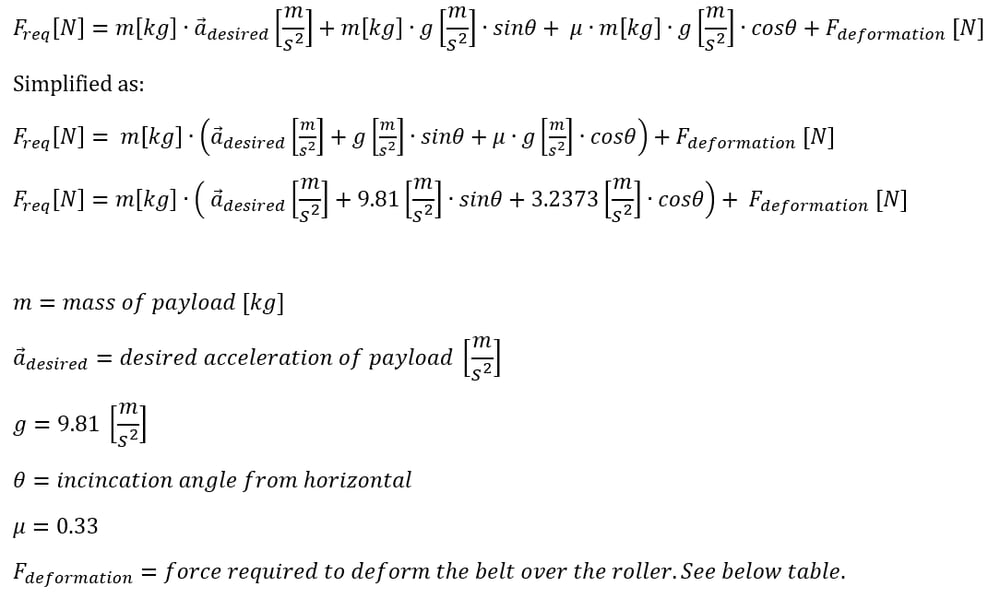
The deformation force you need to enter in the formula above (no load force) for each conveyor width is provided in the table below. This value represents the torque and equivalent force required to deform the belt over the conveyor rollers. The value also includes other small parasitic losses in the system.
| Conveyor Belt Width (mm) | Deformation Force (N) |
|---|---|
| 305 | 44.5 |
| 610 | 89 |
| 914 | 112.7 |
| 1219 | 118.6 |
After obtaining the Required Driving Force from your calculation, compare it to the values in the table below.
Torque and Force
| AC Motor + Gearbox Ratio | 0.5 HP AC Motor + 8:1 Gearbox | 0.5 HP AC Motor + 10:1 Gearbox | 0.5 HP AC Motor + 15:1 Gearbox |
|---|---|---|---|
| Part Number | MO-SM-022-0005 | MO-SM-022-0007 | MO-SM-022-0009 |
| Full - Load Torque Gearbox Output (N.m) | 16 | 20 | 30 |
| Belt Conveyor Force (N) | 419 | 524 | 787 |
These forces are the maximum that the motor can deliver at its Full Load current. If the application requires more force (inclined conveyor orientation or higher acceleration) the conveyor speed might need to be reduced to achieve these values.
Transfer Plate
In some applications, you may need to line up several Dorner 3200 belt conveyors beside each other to move your products. In these cases, you need transfer plates to fill the gap between the conveyors. Transfer plates are installed at the ends of the conveyors. The transfer plate comes in four different dimensions to fit each of our conveyor widths offered (305mm, 610mm, 914mm and 1219mm). In order to use the transfer plate your product needs to have a minimum length of 32 mm. For Dorner 3200, the transfer plates for the drive tail of the conveyor (conveyor end with shaft) are different from the transfer plates for the idler tail of the conveyor (conveyor end without shaft).
AC Motor, Gearbox, and VFD
This kit is a lower-cost alternative to our stepper drives for powering your material-handling operations.
The VFD (variable frequency drive) powers a 1/2HP three-phase AC motor, which can be paired to a 8:1, 10:1 or 15:1 gearbox. It comes pre-wired for mains power, motor power, and three MachineMotion digital input connections. For more information on this kit check out the link below.
Assembly Instructions
- Assemble the Vention extrusion frame.
- Install the Vention Belt Conveyor Mounting Brackets to the T-slot on the Dorner Conveyor using the included T-bar and M6 fasteners. Tighten using your fingers only.
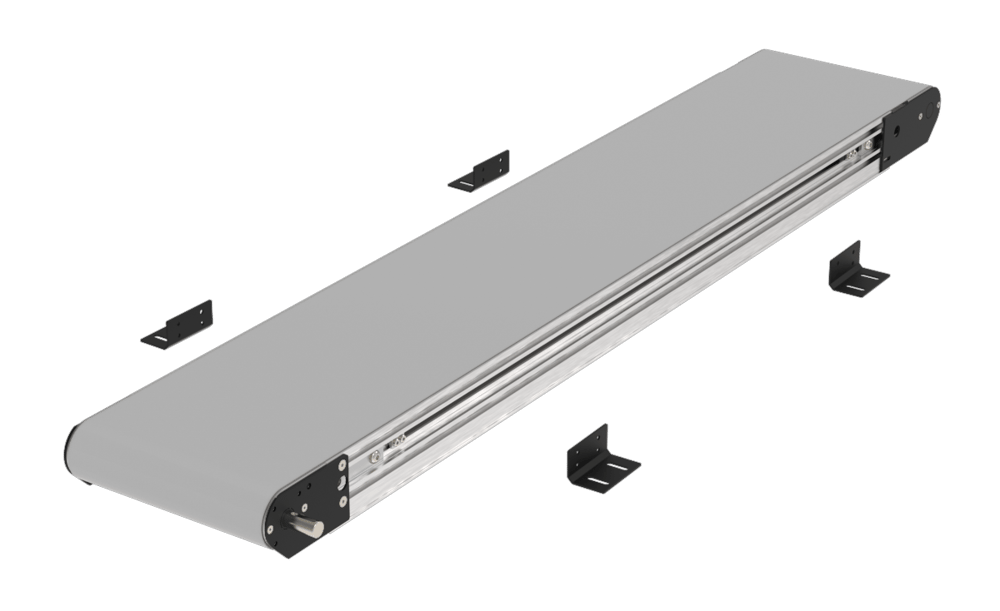
- Mount the conveyor onto the extrusion frame and connect the brackets to the extrusions using the included M8 fasteners. Once the conveyor is mounted in place, tighten the brackets which connect to the conveyor.
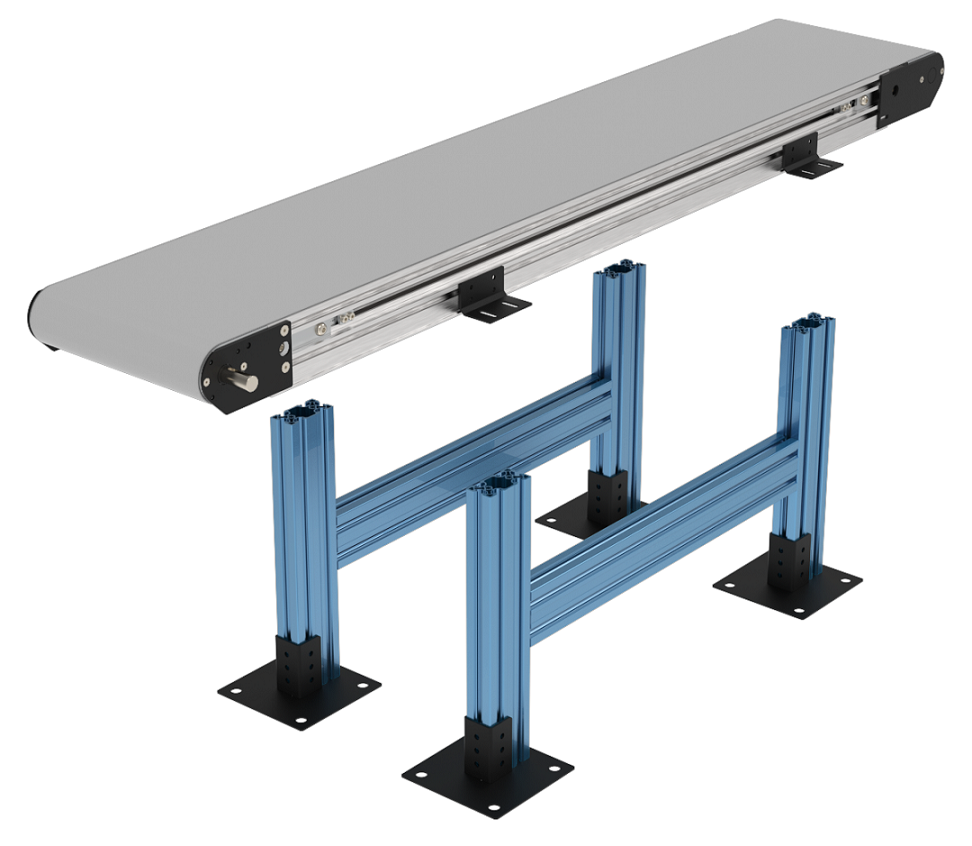
- Install the motor gearbox and motor mount to the input shaft of the belt conveyor.
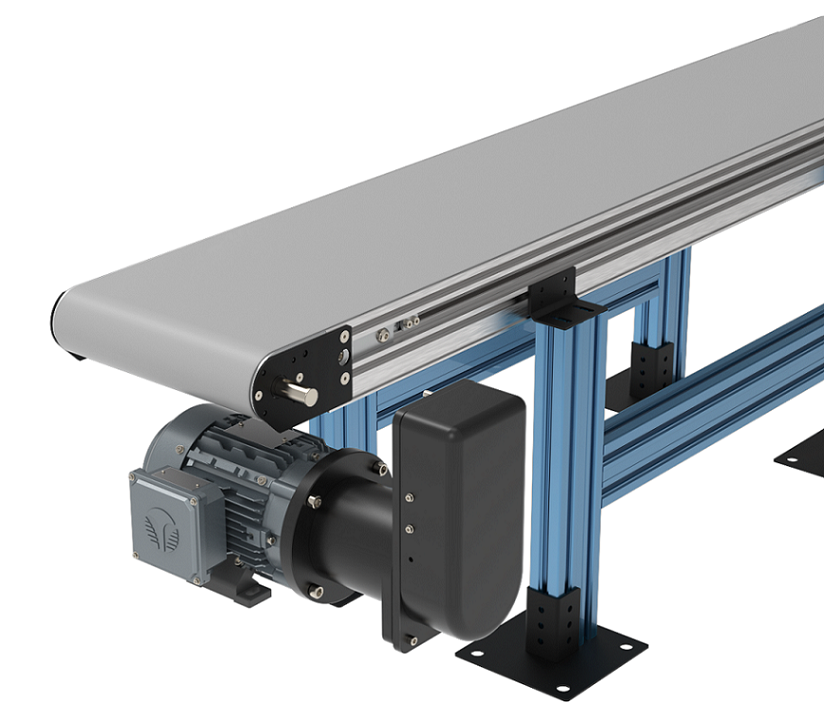
Installing the motor mount
Required Tools:
- Hex key wrenches: 2 mm, 2.5 mm, 3 mm, 5 mm
- Straight edge
- Torque wrench
Installation Component List:
- Bottom Mount Drive Assembly
- Tensioner
- Driven Pulley
- Timing Belt
- M8 Socket Head Screws (2x)
- M6 Socket Head Screws (4x)
- Key
- Drive Pulley
- Cover Screws
- Cover
1-Typical components:
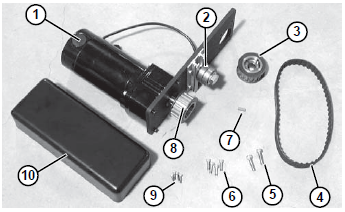
2-Locate drive output shaft (item 1). Remove two (2) M8 screws (item 2) and four (4) M6 screws (item 3) and discard. (figure below)
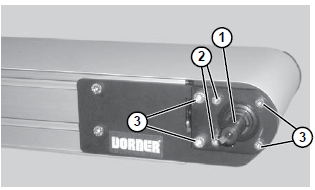
3- Attach bottom mount drive assembly (item 1) with two (2) M8 screws (item 2) and four (4) M6 screws (item 3). Tighten M6 screws to 146 in−lbs (16.5 N−m) and M8 screws to 288 in−lbs (32.5 N−m). (figure below)
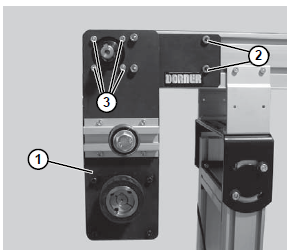
4- Install key (item 1, figure below)
5- Wrap the timing belt (item 2) around the driven pulley (item 3) and drive pulley (item 4). Install driven pulley onto conveyor shaft. (figure below)
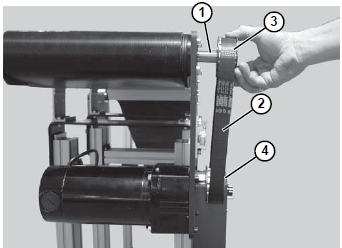
6- Using a straight edge (item 1), align the driven pulley (item 2) with the drive pulley (item 3).
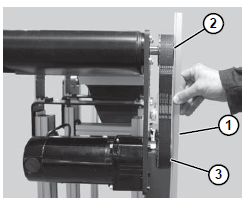
7- Tighten driven pulley taper-lock screws (item 1).
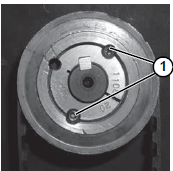
8- Depending on conveyor belt travel (direction A or B), locate the timing belt tensioner (item 1) as shown. Tension timing belt to obtain 1/8 inch (3 mm) deflection for 6 lb (3 Kg) of force at timing belt midpoint (item 2). Tighten the tensioner screw to 110 in-lb (12 Nm).
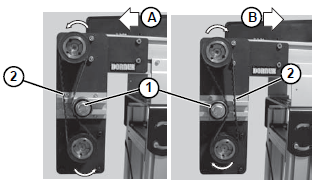
9- Install cover (item 1) with four (4) screws (item 2). Tighten screws to 35 in-lb (4 Nm).
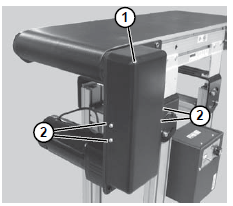
##
Installing the transfer plate
Transfer plate for the drive tail of the conveyor:
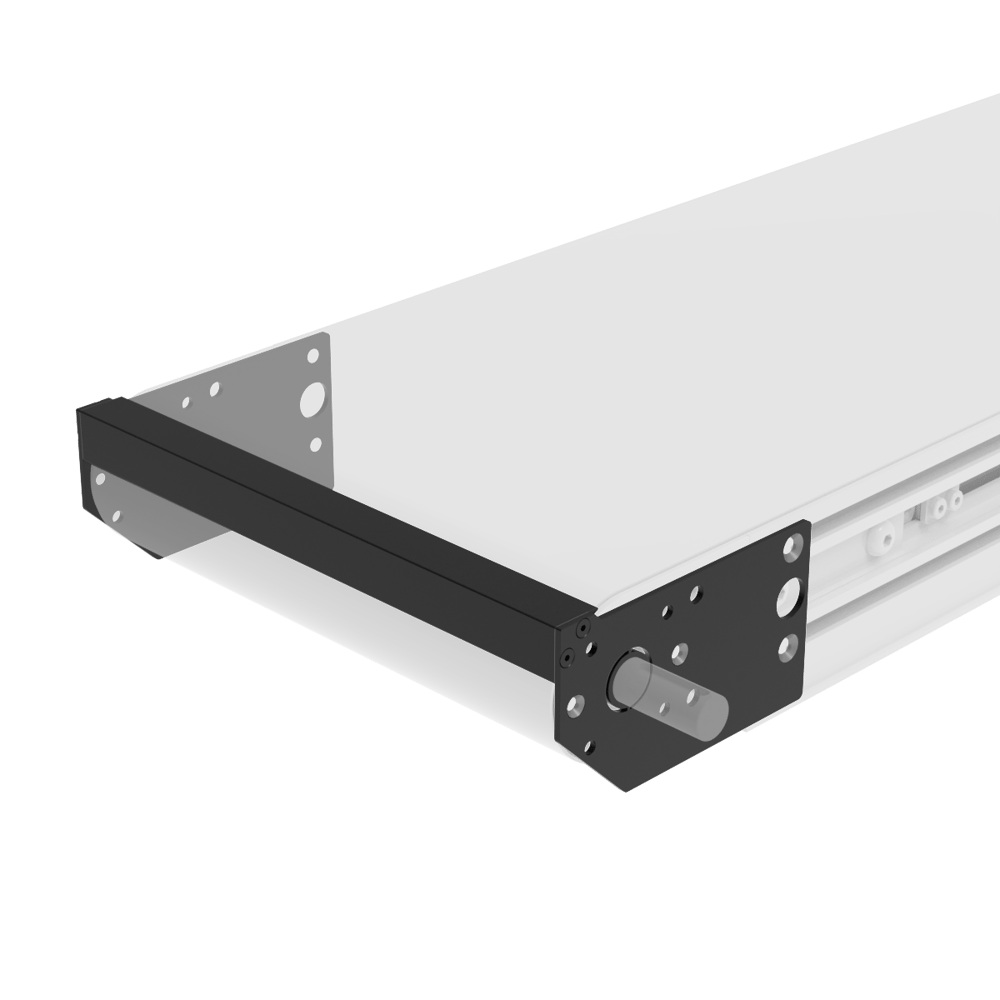
To install the drive tail transfer plate, remove the four countersunk M6 screws in the conveyor end plate, and replace the transfer plate with the end plate. Now use the four M6 countersunk screws to install it. For installing the drive tail transfer plate on the drive side of the conveyor, place the transfer plate before installing the motor mount and spacer plate. Then, use the four M6 socket head cap screws and 2 M8 socket head cap screws that come with the motor mount to fasten the motor mount on top of the transfer plate and spacer plate.

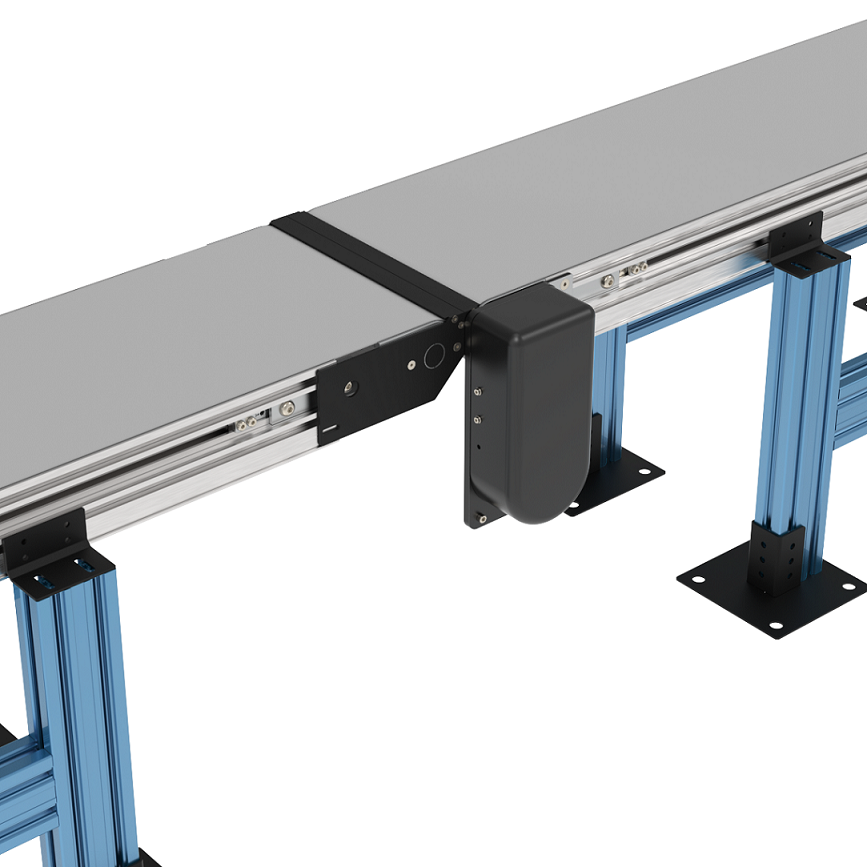
Transfer plate for the idler tail of the conveyor:
The transfer plate for the idler tail of the conveyor is installed at the idler end of the conveyor (conveyor end without the motor mount).
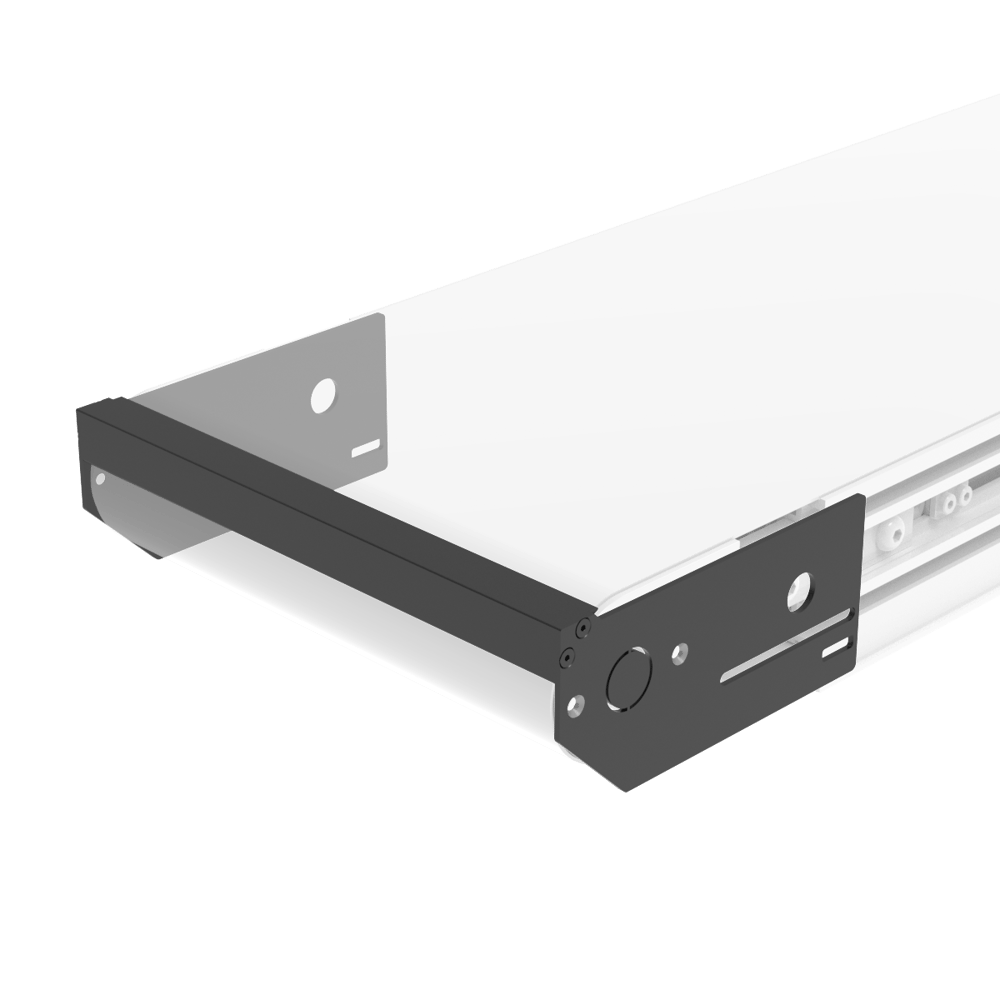
To install the transfer plate for the idler tail, remove the two M5 countersunk in the conveyor end plate and then remove the end plate. Replace it with the transfer plate and fasten it with the same M5 countersunk screws.
Installing the AC motor, gearbox and VFD kit
Safety
Important: Take the following safety precautions when doing any maintenance:
- Never work on energized equipment.
- Always establish the motor connection first before energizing the VFD.
- Routinely inspect the motor and gearbox to ensure all bolts are tightened properly.
Mounting the motor gearbox
The motor-gearbox combination comes pre-assembled.
To mount the motor:
- Apply a small amount of grease to the gearbox output shaft.
- Using the four M6 bolts and washers (provided), attach the gearbox to the conveyor drive input. Ensure the bolts are tightened adequately.
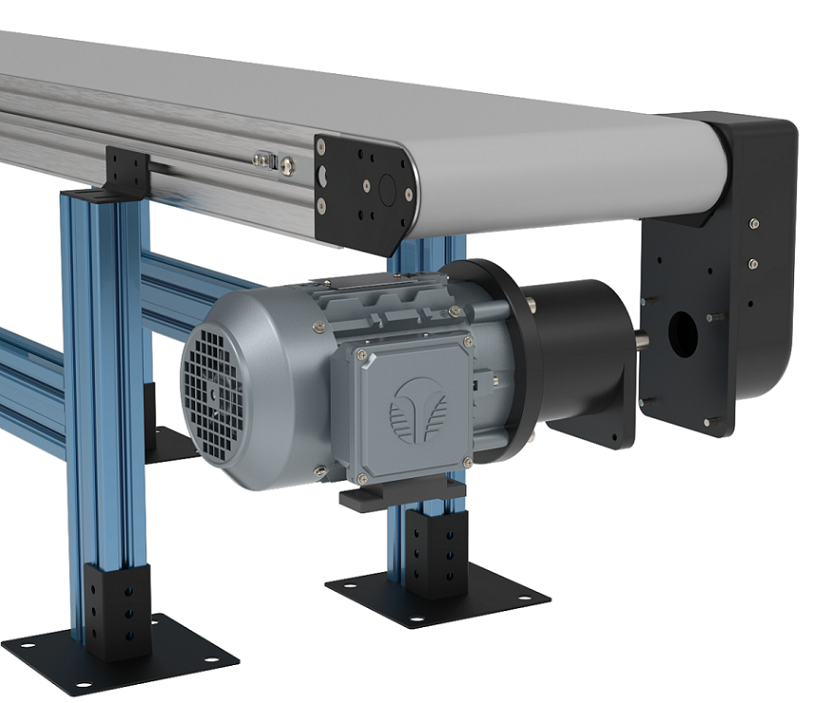
Mounting the VFD
The VFD supplies the motor with power and controls its speed. MachineMotion can communicate with the VFD and control up to three digital inputs, such as the VFD start-stop function, via the digital IO module.
To mount the VFD:
- Select the placement area. Choose a dry place, like the side of the structure supporting the conveyor. Leave 150 mm of clearance below the VFD for its electrical cables, and ensure the VFD is within reach of the 2.5 m-long motor power cable.
- Attach the VFD with the 2 provided M5 T-nuts and bolts. Insert them along the same horizontal t-slot. The fasteners are slightly long, so they can extend from the t-slot and serve as a perch to hook the VFD in for easy access.
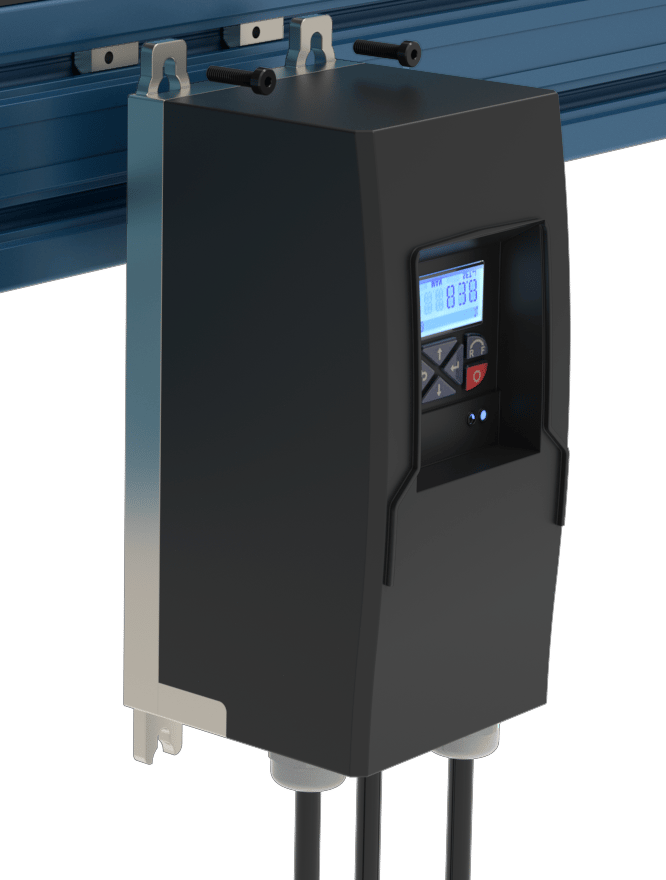
Connecting electronics
Internally, both the AC motor and VFD come pre-wired and configured for basic motor operations. To complete the electrical installation, follow the wiring diagram below:
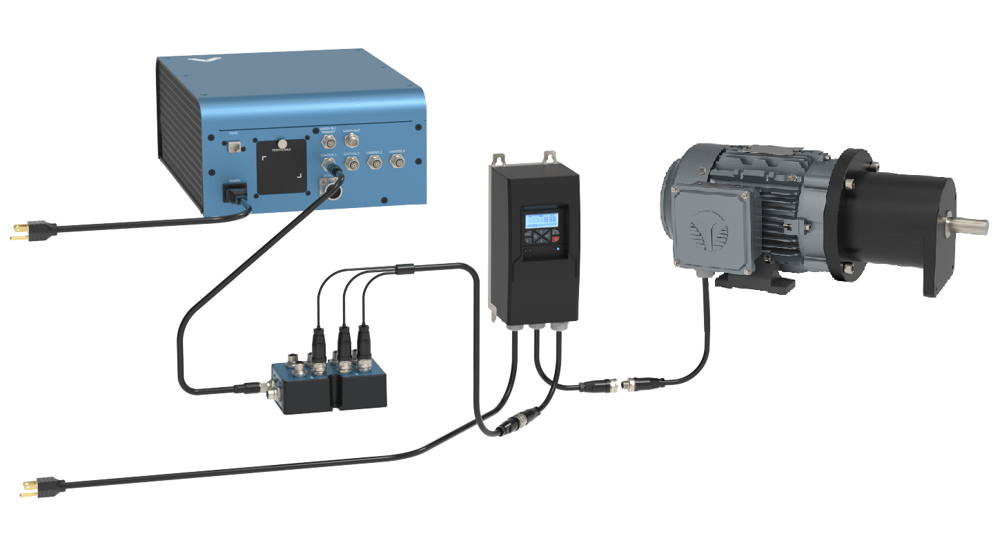
Controlling and programming the VFD
The Lenze VFD is an extremely feature-rich frequency drive allowing for highly configurable control and motor operation. This is possible through modifying and configuring so-called parameters. Parameters are values, stored in the VFD, that control how the motor and VFD behave. Most of the parameters needed for basic function are pre-set and do not need changing.
You can perform operations using the VFD keypad, as described in the table below.
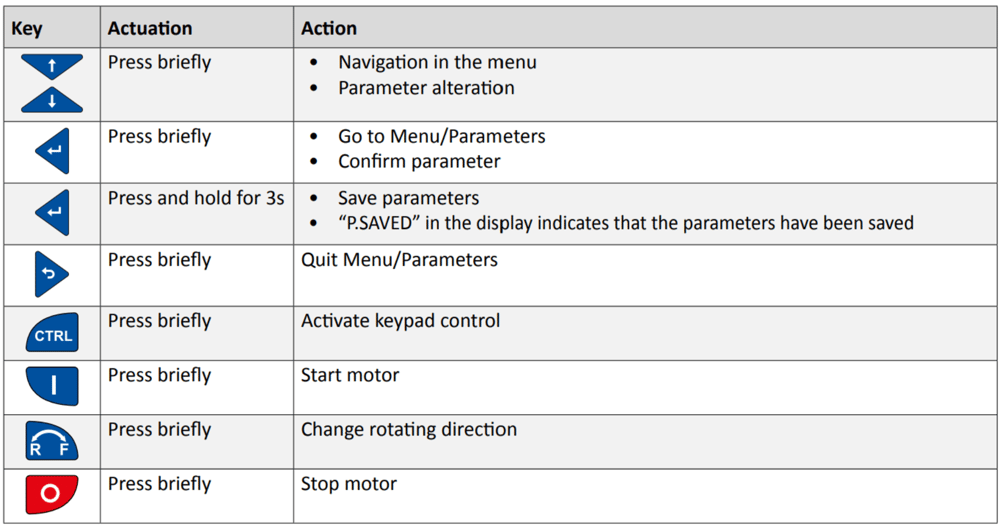
However, you may need to manually configure some parameters if you are modifying motor operating characteristics or setting up certain digital inputs.
To change a parameter:
Press Enter briefly.
With the up and down arrow keys, select the group the parameter is in. Parameters are formatted as PXYY.ZZ, where the first digit after P indicates the group. (For example, parameter P400.01 is in group 4.) Press Enter.
With the up and down arrow keys, select the parameter. Press Enter.
With the up and down arrow keys, change the parameter value. Press Enter to input the change.
To save the new parameter value, press and hold Enter for at least three seconds.
Caution: Incorrect parameters can damage the motor or VFD.
Starting and stopping the motor
You can control the motor directly from the VFD - which is the default, manual option or through MachineMotion, which requires further integration.
Enabling VFD keypad control
- Press CTRL briefly. The screen displays ”Keypad Full CTRL?” and then indicates the desired state (e.g.: “ON” will be displayed as the desired state).
- Press Enter briefly to change from OFF to ON. A red error light will begin to flash when keypad control is enabled, this is normal.
Control via VFD keypad
To control the motor directly from the VFD, press the following buttons:
- (I) key. Start motor, press briefly.
- UP and DOWN arrow keys. Change frequency (motor RPM). There is no direct RPM feedback.
- R-F key. Change directions.
- (0) key (in red). Stop motor.
Control via MachineMotion
To control the motor remotely via MachineMotion, you will need to set up remote triggering of digital inputs (such as a start-stop function). This requires a MachineMotion, the Digital IO Module (CE-MD-001-0000__2) and Tower Light Cable, seen as the triple splitter cable above (CE-CA-051-5000), sold separately.
The following step-by-step guide will run through the example of setting up the “start-stop” and “forward-reverse” digital inputs:
- Establish the connection of the Digital I/O module to the MachineMotion via any of the four available control ports.
- Connect the triple splitter cable as follows:
- Connector labelled Red to Digital Output 0 (start-stop trigger)
- Connector labelled Blue to Digital Output 1 (reverse trigger)
- Connector labelled Green is not used
- Establish the connection with the splitter cable to the VFD as seen above.
- With the VFD keypad control enabled, navigate to parameter menu P210.00, which is the minimum motor frequency. It is natively set to 0 Hz, however will be required to be set at the desired operating frequency. Set the desired value using the UP and DOWN arrow keys and press Enter once the desired value is achieved.
- Return to the main menu and disable keypad control. Note the displayed text on the screen indicating “KSTOP”.
- Press the motor start button (I). It should now read “STOP”. You are now ready to control the VFD from MachineLogic.
- In MachineLogic, under Manual Control, enable Digital Output 0, the motor should spin up to the previously set frequency.
- With Digital Output 0 still triggered, enable Output 1, the motor should decelerate and reverse direction back up to the previously set frequency.
For a list of additional available digital inputs and a step-by-step programming guide, see Lenze’s i510 commissioning guide, section 6.2: lenze.com.
If you have any questions or concerns about configuring VFD parameters, Vention’s customer success team can assist you.